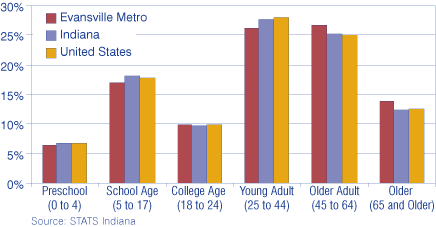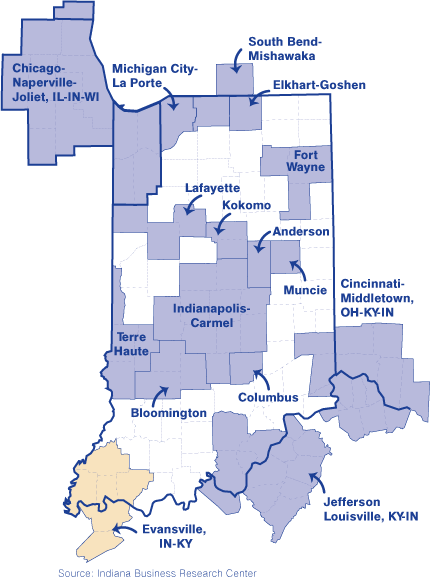The Evansville Metro Story: Told by STATS Indiana
The New Year brings with it many new things (in addition to resolutions that are meant to be broken). As part of the re-launch of STATS Indiana, the new year brings innovative ways to access data. The USA Counties and Metros Side by Side feature provides a useful way to compare any U.S. county or metro to another county, metro, micro, state, nation or custom area. It is available directly at www.stats.indiana.edu/uspr/a/sbs_profile_frame.html or by clicking the "USA Counties and Metros Side by Side" link from the STATS Indiana home page. While this function allows for a comparison of up to four geographic areas, this series of articles will only use three: an Indiana metro, Indiana and the United States. There will be 16 articles in this series, one for each metro in Indiana (see Figure 1). This month, we will focus on the Evansville metro.
Figure 1: Indiana Metro Areas
The Area
The Evansville metro includes six counties, four of which are contained within Indiana's boundaries: Gibson, Posey, Vanderburgh and Warrick counties. The other two counties (Henderson and Webster) are in Kentucky.
There were slightly more than 350,000 people in the Evansville metro in 2006, a growth of 7.8 percent since 1990. This growth rate lags both the state and the nation, which saw populations increase by 13.9 percent and 20.3 percent, respectively, over the same period. This fact could have something to do with Evansville's aging population: the Evansville metro has a higher percentage of people in the 45-64 age group and the 65 and older age group compared to Indiana and the United States (see Figure 2). This higher percentage of older adults coupled with a smaller proportion of young adults (26.2 percent) when compared to the state (27.6 percent) and nation (28.1 percent), has the potential to adversely affect Evansville's labor force.
Figure 2: Percent of Total Population in Each Age Group, 2006

On average, Evansville metro residents have a little more room to roam before running into another person than Indiana overall, with about 153 people per square mile. That's about 23 fewer people per square mile when compared to the state, but about 68 more people per square mile than the national level.
Jobs and Wages
As many Hoosiers are aware, Indiana's manufacturing sector employs a higher proportion of workers (19.6 percent) than in the nation overall (10.6 percent). The Evansville metro is no exception. In fact, of Evansville's 170,865 total covered employment jobs, 19.9 percent (or 34,020 jobs) were in manufacturing in 2006 (see Figure 3). Health care and social services was next in line for the highest proportion of jobs, making up 12.8 percent of total covered employment in the Evansville metro. Retail trade employed the third highest proportion of workers, coming in at 10.9 percent for the metro. These three industries—manufacturing, health care and social services, and retail trade—ranked among the top three in the Evansville metro, Indiana and the United States.
Figure 3: Industry Wages as a Percent of Total Nonfarm Wages, 2006

One industry that stands out as relatively odd for its proportion of jobs in the Evansville metro is the educational services industry, employing 2.4 percent of workers. Compare that to 8.3 percent and 8.8 percent of workers in Indiana and the United States, respectively. This industry ranked fourth for its proportion of workers in the state and nation, but 11th for the metro. However, it is important to note that some counties are not included in the Evansville figures due to federal nondisclosure requirements, so that 2.4 percent figure does not tell us much.
Wages across all industry sectors in Indiana and the Evansville metro are lower than the nation's wages. In 2006, the Evansville metro was doing better than Indiana in terms of wages, coming in at 86.7 percent of U.S. wages. Indiana paid workers 85.9 percent of the national level. What's the difference in dollar terms? Average wages were $42,535 in the United States, $36,533 in Indiana and $36,860 in the Evansville metro.
The good news is that overall wages have increased in each area from 1996 to 2006. In Evansville, this change (a 14.5 percent increase) was similar to that of the United States (a 14.8 percent increase). Meanwhile, Indiana grew at about half the nation's rate, or 7.7 percent, widening the gap between wages in the state and the United States (see Figure 4).
Figure 4: Average Annual Wages, 2006

Conclusion
Over the past 10 years, the Evansville metro economy has grown. The metro's population, number of jobs and wages paid to workers have all increased. Comparing the area to the state and nation, however, gives a more interesting perspective: While the Evansville metro economy has sometimes grown faster than Indiana's economy, it has often lagged the nation.
These comparisons are easily made using data from the USA Counties and Metros Side by Side feature, and these side by side profiles have even more to offer. For housing, the labor force, commuting data and more, visit STATS Indiana today.
Molly Manns, Associate Editor
Indiana Business Research Center, Kelley School of Business, Indiana University

